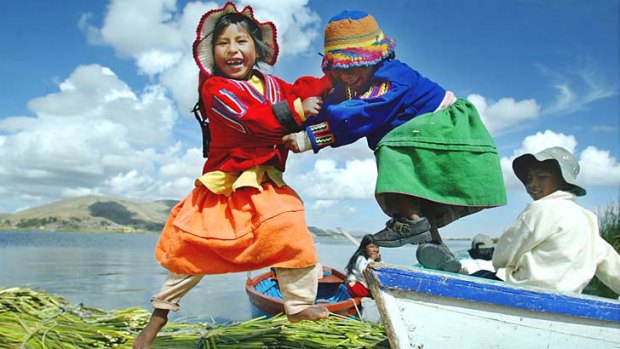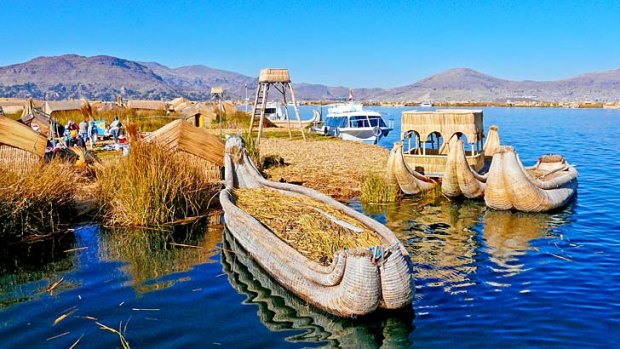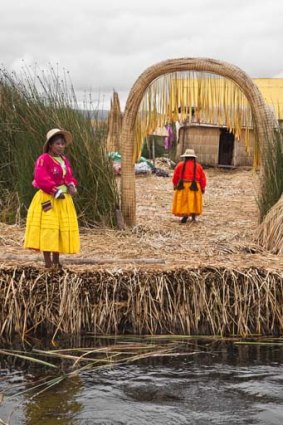
Hold steady ... Uros children at play.Credit: Reuters
Garry Maddox joins Peru's Uros people for lessons in survival, 21st-century style, on Lake Titicaca's floating islands.
Her name is Rosalinda. Cute, chubby-cheeked and most likely 11 years old. She calls me "Warry" . Then "Who-ree" and "How-rie". In a small reed hut, where two babies lie on a mattress like plump snapper on a fish-market counter, Rosalinda and her mother slip me into a bright-red ceremonial vest and beanie. A picture opportunity beckons - almost certainly a candidate for awkwardtouristphotos.com.
I'm on one of the famous floating islands on Peru's Lake Titicaca. Population: 15. Three families live on this artificial island of just 300 square metres. And even if you've heard of the Uros in school lessons, it's still a surprise to step onto the spongy surface and meet the locals.

Islands and boats are made of reeds.Credit: Getty Images
Those lessons, if you slept through them, would have mentioned that the Uros people built their islands from totora, or floating reeds, on the world's highest navigable lake - 3820 metres above sea level. When the Incas and the Collas drove this indigenous community into the lake centuries ago, they lived firstly on reed boats, then used the same material for islands that could be moved if threatened.
More than 2000 people reputedly live on more than 60 islands, each anchored to posts in the 165-kilometre-long, 60-kilometre-wide lake adjoining Bolivia. In the digital era, the Uros islanders remain hunter-gatherers, of a kind. On the ferry trip from the busy city of Puno to the island of Taquile then back to the floating islands, our guide, Roger Yanarico, says the Uros still fish, shoot waterhens with rifles, collect eggs - carefully leaving as many as they take - and eat the white root of the reeds that underpin their lives. "It has lots of iodine," he says. "Good for teeth and avoiding the goitre."
While retaining the basics of their culture, the Uros have adapted to the 21st century, reflecting the changes to indigenous communities in other parts of the world as tourism becomes a vital source of income. I notice the first adaptation approaching the island. As I film with an iPad, the symbols popping up on the screen show these isolated, Aymara-speaking hut dwellers are well equipped when it comes to mobile phones.

Entrance to a floating community.Credit: Getty Images
Four colourfully dressed women - one with a wicked gap-toothed grin - wave warmly as the ferry pulls in. "Kamisaraki," they chorus.
Yanarico, who grew up on the lake's edge and moved to Puno to study tourism and English, has already explained something of how the islanders span the traditional and modern. While they have a healthy lifestyle based on a fish diet and prefer natural medicines - "plants, animals, some special clay" - the Uros have also built a small health centre. Children row to a primary school on one floating island, though once they reach high school and university it's a five-kilometre boat trip to Puno. Although there's no electricity, some islanders have solar panels for hot water. "They also have black-and-white TVs that run off batteries," Yanarico says. They travel to the mainland to shop, sell embroidery and handicrafts to tourists, visit restaurants and discos, take part in fiestas in Peru's folkloric capital and visit internet cafes. "All the clothes they have they buy in Puno because they don't have llamas and alpacas," Yanarico says.
But the Uros do keep pigs, which feed on the reed roots and swim across the channels between the islands. Most people here are said to consider themselves Catholics but still follow their ancestors in believing in the mother lake, the sun, moon and the god of the high mountains. They no longer have a Catholic church: the reeds rotted and it sank.
On the island, Yanarico demonstrates totora building techniques using small reed models of huts. No DAs required here. A metre of dense reed root is the foundation for another metre of crosshatched reed. As the reeds rot, new layers are added. Weighing up to 15 tonnes, the island is anchored at various points.
Near a group of men building a reed canoe and a rickety tower that hints at the ancestral need to watch for more aggressive tribes, there is a netted-off hole that is a trout farm.
The woman with the wicked grin who greeted us earlier lifts the island equivalent of a manhole cover and drops a line tied to a rock. Counting in Aymara, she demonstrates the water is 20 metres deep. Elsewhere, the lake reaches 280 metres. Then comes what feels like a touching moment as young Rosalinda and her mother lead me by the hand to the family's hut to costume up. As I emerge from the semi-darkness, I realise ferry passengers are emerging from other huts in ceremonial outfits, too, for their own contribution to awkwardtouristphotos.com.
There are well-stocked handicraft stalls and it quickly becomes apparent just how much tourism contributes to the Uros economy. Buying crafts is a fair exchange for this cultural experience, of course, but it comes with a certain amount of not-so-subtle pressure. Rosalinda could give Anthony Robbins a lesson in high-powered salesmanship. Having bought a hand-woven wall hanging, cushion cover, jewellery and pictures, I have to resist her encouragement to accumulate more handicrafts. If I ever start a retail business in Australia, I want Rosalinda as head of sales.
Tourists can stay overnight on some islands, but we are returning to Puno. As we board the ferry, the four women who welcomed us to the island wave farewell. Senorita Gap Tooth winks and flashes that wicked smile. "Hasta la vista, baby," she says.
Garry Maddox travelled courtesy of LAN and Adventure World.
FAST FACTS
Getting there
LAN Airlines has a fare to Lima from Sydney for about $2770 low-season return, including tax. Fly to Santiago (16hr, including transit time in Auckland), then to Lima (4hr); see lan.com. Melbourne passengers pay about the same and fly with Qantas to and from Auckland to connect.
Staying there
In Puno, the Sonesta Posadas del Inca, which overlooks Lake Titicaca, has 62 rooms from 695 nuevo sol ($253) a night; see sonesta.com/laketiticaca.
Touring there
Adventure World has an eight-day Inca Route: Lima to La Paz independent tour visiting Cuzco, Machu Picchu, the Sacred Valley, Puno and La Paz, from $1620 a person, including internal domestic flights, transfers and hotel accommodation. See adventureworld.com.au.
Eating there
In Puno, the Casa Andina hotel's restaurant features local produce; see casa-andina.com.
More information
See visitperu.com.
Sign up for the Traveller Deals newsletter
Get exclusive travel deals delivered straight to your inbox. Sign up now.